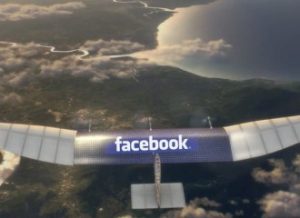The drone called Aquila in June of this year made a test flight, which was completed successfully without any breakdowns. At the end of June 2016, Facebook developers have already conducted a flight test. The test flight failed, since the aircraft was partially destroyed after an unsuccessful landing.
The size of the drone is comparable with the dimensions of the Boeing, and its shape resembles a flying wing. Engineers of Facebook have equipped it with quite powerful solar batteries, which allow not only to rise to the sky, but also to soar there for quite a long time.
During the test flight, the drone spent about two hours in the air. The flight passed over the state of Arizona. Drone managed to gain a height of 1 thousand meters and after the test successfully landed.
The drone of Facebook appeared in the cancers of the initiative to distribute the Internet in the most unsecured and hard-to-reach parts of the globe. This idea arose in the head of the company Mark Zuckerberg in 2015. Two years the active work of a team of leading engineers was conducted, which at the moment was crowned with success.
 Drone Aquila is able to distribute the Internet at a high speed – about 10 gigabit per second.
Drone Aquila is able to distribute the Internet at a high speed – about 10 gigabit per second.
The weight of the drone is approximately equal to the weight of the car. The size of it is impressive: the wingspan is 42 meters, and this is more than the “Boeing 737”. An innovative aircraft can be in flight mode around the clock. In the afternoon, it receives energy from the sun, and at night it feeds on accumulated solar energy accumulators. Engineers installed on the drone quite powerful batteries that are able to supply it with energy for 13 hours. The developers say that the daily altitude of the flight Aquila will be 27 kilometers. At night, the drone will be lowered to 18 kilometers in order to save energy. It should be noted that passenger aircraft operate at an altitude of 12 kilometers.
 Facebook engineers also note the extreme energy efficiency of their development. Dron needs only 5 thousand watts for full-time work. To make it clearer – 3 conventional hair dryers consume more than a drone.
Facebook engineers also note the extreme energy efficiency of their development. Dron needs only 5 thousand watts for full-time work. To make it clearer – 3 conventional hair dryers consume more than a drone.
The drone has low aerodynamic resistance. The unsuccessful first flight became such precisely because of this feature. Aquila at landing just could not lose speed, so it suffers a lot from falling. The drone is not equipped with a chassis, it lands on the lower packed part. Engineers designed the device in such a way that such an extraordinary landing did not harm the engines, so they were protected by a special body. After an unsuccessful flight, the developers of the drone installed spoilers that help regulate resistance.
At the moment, the drone is still being finalized. Engineers of Facebook intend to equip the aircraft with numerous sensors and sensors to check the performance of its work at various heights.

